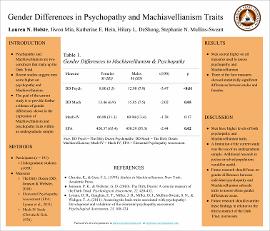| dc.contributor.advisor | Mullins-Sweatt, Stephanie N. | |
| dc.contributor.author | Holste, Lauren N. | |
| dc.contributor.author | Min, Jiwon | |
| dc.contributor.author | Hein, Katherine E. | |
| dc.contributor.author | DeShong, Hilary L. | |
| dc.date.accessioned | 2022-04-13T14:44:26Z | |
| dc.date.available | 2022-04-13T14:44:26Z | |
| dc.date.issued | 2022-04-19 | |
| dc.identifier | oksd_URS_2022_holste | |
| dc.identifier.citation | Holste, L. N., Min, J., Hein, K. E., DeShong, H. L., & Mullins-Sweatt, S. N. (2022, April 19). Gender differences in psychopathy and Machiavellianism traits. Poster session presented at the Oklahoma State University Undergraduate Research Symposium, Stillwater, OK. | |
| dc.identifier.uri | https://hdl.handle.net/11244/335216 | |
| dc.description.abstract | Purpose/Background: Psychopathy and Machiavellianism are the two constructs that make up the Dark Triad alongside the construct of narcissism. The Dark Triad describes three personality traits significantly associated with difficulties in interpersonal relationships. While some argue that psychopathy and Machiavellianism are extremely similar (Miller et al., 2016), a number of researchers argue they are different enough to be separate constructs. Recent studies have found gender differences within psychopathy or Machiavellianism individually. Specifically, men expressed higher levels of both psychopathy traits (Miller et al., 2010) and Machiavellianism traits (Collison et al., 2020). However, no study has examined gender differences in both Machiavellianism and psychopathy. The goal of this study is to provide further evidence of gender differences shown in the expression of Machiavellianism and psychopathy traits within one sample. | |
| dc.description.abstract | Methods: Participants (N = 191) for the current study were undergraduate college students from Oklahoma State University who worked over 20 hours a week, as this data comes from a larger study that assessed workplace behaviors. Participants were given research credits for participation. Participants completed a variety of self-report measures to assess psychopathy, Machiavellianism, and narcissism. These measures included demographic information (e.g. sex), The Dirty Dozen (DD; Jonason & Webster, 2010), Elemental Psychopathy Assessment (EPA; Lynam et al., 2011), and Mach-IV Scale (Christie & Geis, 1970). The sample was 71.8% female and 74.8% Caucasian. Gender differences will be measured for Machiavellianism, psychopathy, and narcissism. A series of T-tests will be used to determine whether there are significant gender differences in psychopathy and Machiavellianism traits. | |
| dc.description.abstract | Results: It is hypothesized that males will express significantly higher levels of psychopathy traits and Machiavellianism traits. | |
| dc.description.abstract | Implications: This study will provide further evidence whether there are significant gender differences in psychopathy and Machiavellianism. Knowing the prevalence of these traits in males and females will aid in diagnoses, treatments, interventions, and further research. | |
| dc.description.sponsorship | Oklahoma State University. Freshman Research Scholars Program | |
| dc.format | application/pdf | |
| dc.language | en_US | |
| dc.publisher | Oklahoma State University | |
| dc.rights | In the Oklahoma State University Library's institutional repository this paper is made available through the open access principles and the terms of agreement/consent between the author(s) and the publisher. The permission policy on the use, reproduction or distribution of the article falls under fair use for educational, scholarship, and research purposes. Contact Digital Resources and Discovery Services at lib-dls@okstate.edu or 405-744-9161 for further information. | |
| dc.title | Gender differences in psychopathy and Machiavellianism traits | |
| osu.filename | oksd_URS_2022_holste.pdf | |
| dc.description.department | Psychology | |
| dc.type.genre | Poster | |
| dc.type.material | Text | |
| dc.type.material | Dataset | |
